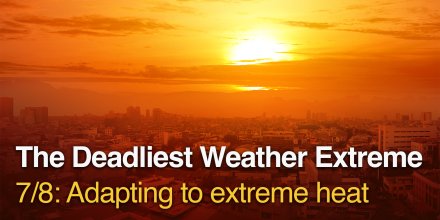
Webinar: Climate Data Tools for Resilient Urban Planning
This second webinar in the series presents digital tools that turn climate data into actionable strategies for urban resilience.


This second webinar in the series presents digital tools that turn climate data into actionable strategies for urban resilience.

Rising heat risks demand better planning, stronger warning systems, and targeted adaptation strategies.
|
|
|||||||||
|---|---|---|---|---|---|---|---|---|---|
|
Icon
|

|

|

|

|

|

|

|

|
|
|
Temperature (°F)
|
|||||||||
|
Temperature felt (°F)
|
77° |
77° |
78° |
79° |
76° |
74° |
76° |
77° |
|
|
Wind direction
|
SW |
SW |
SSW |
SSW |
SSW |
SSW |
SSW |
SW |
|
|
Wind speed (mph)
|
SW
12-19
12-19
|
SW
11-18
11-18
|
SSW
17-25
17-25
|
SSW
20-29
20-29
|
SSW
21-30
21-30
|
SSW
17-27
17-27
|
SSW
13-21
13-21
|
SW
11-19
11-19
|
|
|
Precipitation (in/3h)
|
-
0%
-
|
-
0%
-
|
-
0%
-
|
-
0%
-
|
-
0%
-
|
-
0%
-
|
-
0%
-
|
-
0%
-
|
|
|
Precipitation probability
|
0%
|
0%
|
0%
|
0%
|
0%
|
0%
|
0%
|
0%
|
|
|
Precipitation hourly
|
|||||||||
|
Precipitation hourly
|
No precipitation expected |
||||||||
|
rainSPOT
Precipitation distribution within 20 km
|
|
||||||||
| Sea/surf forecast | ||||||||
|
Significant wave height (m)
|
||||||||
|---|---|---|---|---|---|---|---|---|
|
Significant wave direction in which the waves move
|
||||||||
|
Water temperature (°F)
|
76° |
76° |
76° |
76° |
77° |
77° |
77° |
76° |
During the night and in the first hours of the day it is mostly cloudy, but most clouds give way in the afternoon. The sun will not be visible. Temperature highs are likely to reach 81 °F. The UV-Index climbs up to 11, don't forget to use sunscreen when spending the day outside. Overnight into Saturday expect a moderate breeze (12 to 18 mph). In the course of day blows a fresh breeze (18 to 25 mph). Winds blowing from Southwest. The weather forecast for Adale for Saturday is expected to be very accurate.
Pressure: 1011 hPa
Timezone: EAT (UTC +03:00h)
By comparing today's temperatures to 40 years of historical data we can see whether today's forecast is unusually warm (red areas) or cold (blue areas). Coloured dots show observed actual temperatures from professional and private weather stations.
The real-time satellite image combines visible light during daytime with infrared radiation during nighttime. At night, the image is not dark as infrared radiation can detect temperature differences. Unfortunately, low clouds and fog are difficult to distinguish from ground temperatures and thus can be almost invisible during the night. Meteosat satellite images for Europe are updated in real-time every 5 minutes. GOES-16/GOES-17 (North & South America) and Himawari (Asia) images update every 10 minutes.
Precipitation is estimated from radar and satellites. Precipitation estimates from satellites are less accurate at night than during daytime.
© 2025 meteoblue, NOAA Satellites GOES-16 and EUMETSAT. Lightning data provided by nowcast.
The location marker is placed on Adale. Orange crosses indicate lightning. Data provided by nowcast.de (available in USA, Europe, Australia). Drizzle or light snow fall might be invisible for the radar. Precipitation intensity is colour coded, ranging from turquoise to red.

This second webinar in the series presents digital tools that turn climate data into actionable strategies for urban resilience.

Rising heat risks demand better planning, stronger warning systems, and targeted adaptation strategies.
Advertising is essential to maintain our free website with unique detail and accuracy.
Please whitelist www.meteoblue.com on your ad blocker or consider buying one of our products:
Already have a subscription?
Then please login.